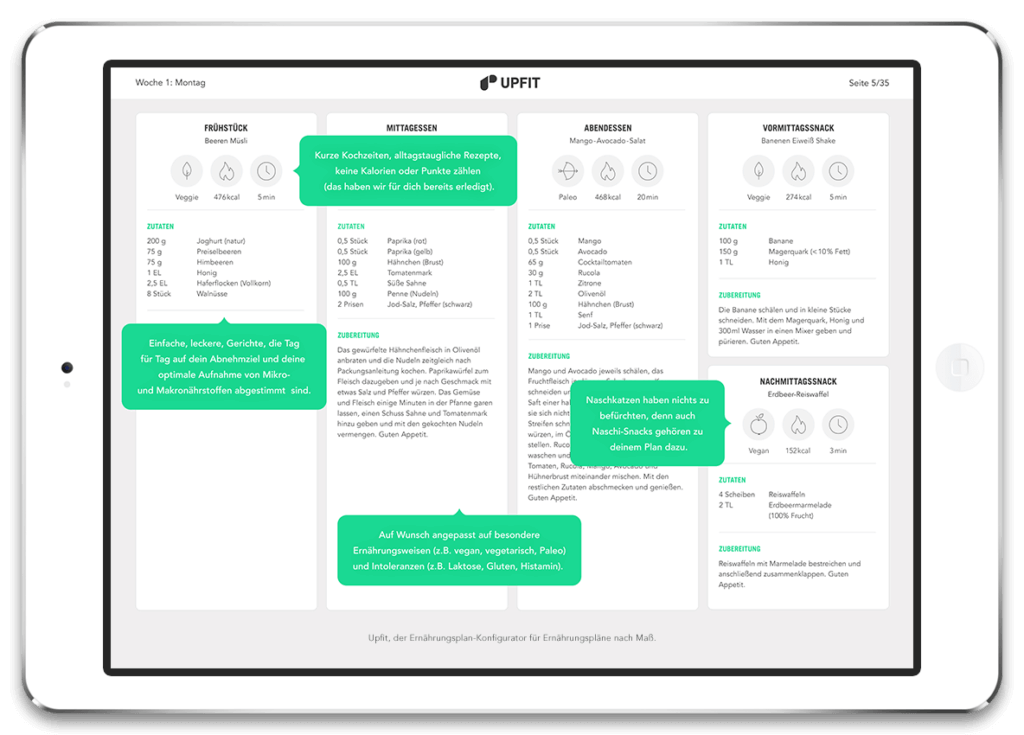Upfit Calorie Calculator - Explore your calorie need in 2 min
With Upfit’s Calorie Calculator, you can quickly and easily calculate your caloric needs and determine your perfect macronutrient and micronutrient distribution for weight loss, clean eating, muscle building and definition. On request, you can also receive recipes for your personal calorie and nutrient needs for one day.
100% Free
Science-based
Incl. Macro- & Micronutrient Calculation
Why should you know your caloric needs?

Targeted to reach your dream weight – many diets fail because they aren’t individually adjusted to your personal calorie consumption. Anyone who successfully and sustainably losses weight or builds muscle knows how important it is to know their personal caloric needs. Because: At the end of the day, the calorie balance is always crucial for achieving the goal. Everyone knows, if you eat fewer calories than you burn, you lose weight – simple logic! But exactly how much do you burn? and how much should you eat to reach your goal? The Upfit Calorie Calculator can answer that.
What is a calorie?
The term “calorie” is derived from the Latin word “calor” which means heat. So it is not surprising that both energy and heat are given in calories. 1000 calories equals the amount of energy, or heat, needed to heat 1 liter of water by 1 degree Celsius.
A calorie is thus a measure of the amount of energy that a person gets from his food. If food did not contain calories, we would simply starve to death. The more calories a food contains, the more energy it provides. Accordingly, foods may have different calorie densities. Thus, alcohol, with about 7 kcal per gram, has a higher calorie density than protein and carbohydrates, each with about 4 kcal per gram. Fat has the highest calorie density at approx. 9 kcal per gram.
| Per 1 Gram | Caloric Value |
|---|---|
| Fats | 9,3 kcal / 39 kJ |
| Carbohydrates | 4,1 kcal / 17 kJ |
| Proteins | 4,1 kcal / 17 kJ |
| Ethanol (Alcohol) | 7,1 kcal / 29 kJ |
Difference between calories and kilocalories
On food packaging, the calories of the food are always given in “kcal”, which stands for “kilocalories”. Are calories and kilocalories the same? No. These are in fact two different units of measure. One kilocalorie equals 1000 calories. In everyday language, the abbreviation “calorie” prevailed, however this actually means kilocalories. In fact, 100 grams of fat do not have “930 calories”, but 930,000 – or 930 kilocalories. By the way, by the end of the 1970s, the calorie was officially replaced by the international unit Joule. Since 2010, the calorific values of food in the EU must be displayed in kilojoules per 100 grams. The additional information in kilocalories is also permissible. One kilocalorie is equivalent to about 4.2 kilojoules. However, this new unit of measurement has never really established itself in the common colloquial language, which is why the calorific value of food is still always given in kilocalories. At the end of the day, it does not matter who uses kilocalories or kilojoules. The knowledge about the calorific value of food is of little use, if you do not know your own calorie requirements.
This is how your caloric needs are determined

Your calorie needs are primarily made up of two components: your basal metabolic rate and your physical activity level. Together, these two values make up your total energy expenditure, and thus your actual optimal daily caloric requirements.
Basal metabolic rate
Basal metabolic rate is a theoretical value that describes your body’s calorie expenditure when it is in absolute rest. Such a condition does not exist in reality. Even when sleeping, energy is consumed. Basal metabolic rate is the amount of calories your body needs to maintain itself and keep all vital functions running.
Physical activity level
Your physical activity level includes all the calories that you additionally burn through physical activity. This includes everything you do: sleeping, walking, talking, eating, and everything else. The basic principle is always: The higher your activity level is, the higher your caloric needs.
Total energy expenditure
Your total energy expenditure makes up your actual daily calorie needs when you combine your basal metabolic rate and your physical activity level. This amount of calories is needed to maintain your current weight and to provide you all the necessary nutrients.
Basal metabolic rate + physical activity level = total energy expenditure
Adapt the Calorie Calculator to your goal

Upfit’s Calorie Calculator distinguishes between these 4 different goals and calculates your calorie and nutrient needs accordingly:
- Weight Loss
- Clean Eating / Maintain Weight
- Muscle Building / Gaining Weight
- Definition / Reduce Fat
Calorie Intake for Weight Loss
A calorie deficit is essential to lose weight. If you give your body less calories than it requires to maintain its weight, you lose weight. The body uses the stored energy reserves, also known as fat deposits. That being said, starving yourself to lose weight is the wrong way! If the calorie deficit is too big, your body will treat the diet as a famine – a slowing down of the metabolism is the consequence. When you finish your diet, your extra pounds are likely to return quickly. Many people quickly return to their original weight after such a crash diet, or gain even more weight than before: this in known as the dreaded yo-yo effect. Knowing your calorie consumption is one of the first steps to successfully losing weight. The Upfit Calorie Calculator takes care of this for you. In addition, it determines the right amount of calories for you to effectively and sustainably lose weight. Further information and helpful tips and tricks can be found in our Upfit Guide to Losing Weight – or just create your individual Upfit nutrition Plan now and start your path to success today.
Calorie Intake to Build Muscle and Gain Weight
To build muscle, your body requires extra energy – more calories than your calorie needs to maintain weight. The extra food provides your body with the energy to build new muscle mass and provide them with sufficient nutrients. The main building material of muscle mass is protein. Therefore, a slight change in your macronutrient distribution is essential. As a general rule, the more muscle you have, the more calories your body burns when at rest. Keep in mind, however, that the calorie surplus should not be too high, as then it will become extra fat. For more information and helpful tips and tricks, see our Upfit Nutrition Guide for Building Muscle – or just create your individual Upfit nutrition Plan now and start your path to success today.
Calorie Intake for Definition
Of course, after a hard workout, you want to reap the rewards and see results. The goal: to get new muscles and reduce excess fat. This is how the hard-trained muscle mass finally becomes visible. The focus is not so much on weight loss in general, but specifically on reducing fat. This process is a bit more difficult because the degree of weight loss and pure fat loss can be very narrow here. A slight calorie deficit and a high-protein diet help you achieve your goal. The Upfit Calorie Calculator can help you choose the correct calorie deficit and the right macronutrient distribution. For more information and helpful tips and tricks, see our Upfit Nutrition Guide for definition – or just create your individual Upfit nutrition Plan now and start your path to success today.
Calorie Intake for Clean Eating or Maintaining Weight
In a healthy diet (clean eating), the body is given exactly the amount of calories it needs to maintain its current weight. The focus here is on the distribution of macro and micronutrients so that the body gets everything it needs for total well-being. The Upfit Calorie Calculator will give you exactly the calorie count and optimal distribution of macronutrients and micronutrients that best suits your body. For more information and helpful tips and tricks, see our Upfit Nutrition Guide to Healthy Eating – or just create your individual Upfit nutrition Plan now and start your path to success today.
Calorie Calculator / calorie requirements for men and women
Apart from weight and size, the gender of a person has a decisive influence on his or her calorie requirement. Men naturally have more muscle mass, which increases the calorie requirement on average. On the other hand, women evolutionarily, tend to have fatty deposits on their hips, buttocks and legs. This is supposed to be suitable for strenuous times such as pregnancy or lactation. The Upfit Calorie Calculator also takes these factors into account and calculates your optimal amount of calories for you and your goal.
This is how the Calorie Calculator works
The free Calorie Calculator from Upfit calculates not only the optimal amount of calories for you and your personal goal, but also your ideal macro- and micronutrient distribution! This makes it the best free calorie calculator on the Internet. The calculator determines various important parameters, such as your height, weight, and activity level. It will help you to determine your calorie consumption in detail and adjust your calorie needs to optimize your goal.
What is the Upfit Calorie Calculator based on?
We rely on a strong scientific basis and specific empirical values to find out how many calories you should eat and from which nutritional components. To calculate your caloric needs, we use the best and most accurate formula – the so-called Harris-Benedict formula. First we determine your basal metabolic rate (1). Then we determine your physical activity level, known as the PAL factor), we then factor in your personal nutritional goal: either an energy surplus (muscle building), energy balance (maintaining weight) or an energy deficit (losing weight, definition). We divide the resulting amount of calories into the 3 macronutrient groups on according to the latest scientific findings (2, 3, 4) and based on the experience of expert practicing coaches and dietitians. The recommendations on micronutrient intake are based on the guidelines of the World Health Organization (5) and the German Nutrition Society (6). The body weight rating in relation to height is expressed in terms of the BMI value based on the research of Adolphe Quetelet and Ignaz Kaup (7). So we can guarantee a secure, working and efficient tool that optimally supports you on your way to realizing your dream body.
Sources
- Amirkalali, B. et al. (2008). Measuring or predicting resting energy expenditure. Indian Journal of Medical Science Vol. 62 No. 7. S. 283-290.
- Arciero, P. et al. (2016). Protein-Pacing Caloric-Restriction enhances body composition similarly in obese men and women during weight loss and sustains efficacy during long term weight maintenance. Nutrients. 2016 Aug 8 (8), S. 476 ff.
- Petersen, J. (2017). Attenuating the side effects of caloric restriction through exercise and increased protein intake. Nutrition & health sciences dissertations & theses (71). University of Nebraska – Lincoln.
- Helms, E. et al. (2014). A systematic review of dietary protein during caloric restriction in resistance trained lean athletes: a case for higher intakes. International journal of sport nutrition and exercise metabolism (24), S. 127-138.
- Weltgesundheitsorganisation (WHO). Link: http://www.euro.who.int/de/home
- Deutschen Gesellschaft für Ernährung (DGE). Link: https://www.dge.de/
- Quételet, A. (1871): L’anthropométrie ou le mesure des differentes facultés de l’homme. Bruxelles: Muquardt, C.









